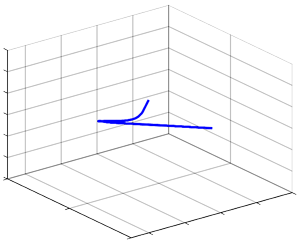Adaptive radar tracking algorithm for maneuverable UAV with probabilistic identification of data using coordinate and amplitude characteristics
DOI:
https://doi.org/10.3103/S073527272212007XKeywords:
FMCW radarAbstract
Small-dimension unmanned aerial vehicles (SUAV) as objects of radar surveillance feature extremely small values of the effective radar cross section and the capability to carry out intense maneuvers and to hover staying still in space. A promising direction of increasing the SUAV detection range by radar is the reduction of detection threshold that results in a significant rise of false alarm probability and is accompanied by the emergence of a substantial number of false pips. For enhancing the SUAV tracking efficiency in the presence of false pips, it has been proposed to use decisive statistics (amplitude information) from the output of optimal receiver of primary signal processing. An adaptive algorithm was developed for the radar tracking of maneuverable SUAV with probabilistic identification of data using the coordinate and amplitude characteristics in the rectangular coordinate system. Accuracy characteristics of extrapolation of SUAV movement parameters and the probability of detecting various types of its motion were obtained using statistical simulation. Probabilities of mistracking and the average time of SUAV trajectory tracking were calculated, and compared with the results of using a well-known algorithm.
References
- V. P. Riabukha, “Radar surveillance of unmanned aerial vehicles (review),” Radioelectron. Commun. Syst., vol. 63, no. 11, pp. 561–573, 2020, doi: https://doi.org/10.3103/S0735272720110011.
- S. I. Makarenko, A. V. Timoshenko, A. S. Vasilchenko, “Counter Unmanned Aerial Vehicles. Part 1. Unmanned aerial vehicle as an object of detection and destruction,” Syst. Control. Commun. Secur., no. 1, pp. 109–146, 2020, doi: https://doi.org/10.24411/2410-9916-2020-10105.
- A. S. Dudush, V. A. Tyutyunnik, A. A. Reznichenko, S. U. Hohoniants, “State of the art and problems of defeat of low, slow and small unmanned aerial vehicles,” Mod. Inf. Technol. Sph. Secur. Def., vol. 1, no. 31, pp. 121–131, 2018, doi: https://doi.org/10.33099/2311-7249/2018-31-1-121-131.
- M. Kunita, M. Sudo, T. Mochizuki, “Range measurement using ultrasound FMCW signals,” in 2008 IEEE Ultrasonics Symposium, 2008, pp. 1366–1369, doi: https://doi.org/10.1109/ULTSYM.2008.0331.
- E. Hyun, Y.-S. Jin, J.-H. Lee, “Moving and stationary target detection scheme using coherent integration and subtraction for automotive FMCW radar systems,” in 2017 IEEE Radar Conference (RadarConf), 2017, pp. 0476–0481, doi: https://doi.org/10.1109/RADAR.2017.7944250.
- A. A. Shpilka, A. Y. Myronchuk, A. O. Tkach, S. P. Overchuk, V. O. Katiuha, Y. A. Myronchuk, “The application of the on-board devices radio direction-finding in the navigation systems of drones,” Mil. Tech. Collect., no. 15, pp. 48–53, 2016, doi: https://doi.org/10.33577/2312-4458.15.2016.48-53.
- S. M. Kostromitsky, D. S. Nefedov, “Estimation of the energy gain when detecting small-sized targets by the ‘Track-before-Detect’ method,” J. “Almaz – Antey” Air Sp. Def. Corp., no. 3, pp. 67–78, 2022, doi: https://doi.org/10.38013/2542-0542-2022-3-67-78.
- D. K. Barton, Radar System Analysis and Modeling. Norwood, MA: Artech House, 2004.
- H. Meikle, Modern Radar Systems. Norwood, MA: Artech House, 2008.
- Y. Bar-Shalom, F. Daum, J. Huang, “The probabilistic data association filter,” IEEE Control Syst., vol. 29, no. 6, pp. 82–100, 2009, doi: https://doi.org/10.1109/MCS.2009.934469.
- V. I. Merkulov, V. S. Verba, A. R. Ilchuk, A. P. Kirsanov, Automatic target tracking in radars of integrated air complexes. Multitarget tracking. Part 3, [in Russian]. Moscow: Radiotekhnika, 2018.
- X. R. Li, “Tracking in clutter with strongest neighbor measurements. I. Theoretical analysis,” IEEE Trans. Autom. Control, vol. 43, no. 11, pp. 1560–1578, 1998, doi: https://doi.org/10.1109/9.728872.
- E. Brekke, O. Hallingstad, J. Glattetre, “Tracking small targets in heavy-tailed clutter using amplitude information,” IEEE J. Ocean. Eng., vol. 35, no. 2, pp. 314–329, 2010, doi: https://doi.org/10.1109/JOE.2010.2044670.
- Z. Li, G. Li, J. Tan, F. Tian, G. Jin, Y. Ren, “Low observable moving target tracking based on modified PDA-AI,” J. Infrared, Millimeter, Terahertz Waves, vol. 31, no. 10, pp. 1245–1256, 2010, doi: https://doi.org/10.1007/s10762-010-9684-2.
- L. M. Ehrman, W. D. Blair, “Probabilistic data association with amplitude information versus the strongest neighbor filter,” in 2007 IEEE Aerospace Conference, 2007, pp. 1–6, doi: https://doi.org/10.1109/AERO.2007.353040.
- S. Y. Zhuk, O. S. Neuimin, I. O. Tovkach, V. O. Chmelov, “Adaptive algorithm for tracking maneuvering targets in a complex jamming environment for a radar with range rate measurement,” in 2020 IEEE 15th International Conference on Advanced Trends in Radioelectronics, Telecommunications and Computer Engineering (TCSET), 2020, pp. 249–254, doi: https://doi.org/10.1109/TCSET49122.2020.235433.
- V. A. Vasin et al., Information technologies in radio engineering systems: textbook for institutes of higher education, [in Russian]. Moscow: Izd-vo MGTU im. N.E. Bauman, 2003.
- Y. D. Shirman, S. T. Bagdasaryan, A. S. Malyarenko, D. I. Lekhovitskii, Radio Electronic Systems. Principles of Construction and Theory. Reference Book, [in Russian]. Moscow: Radiotekhnika, 2007.


